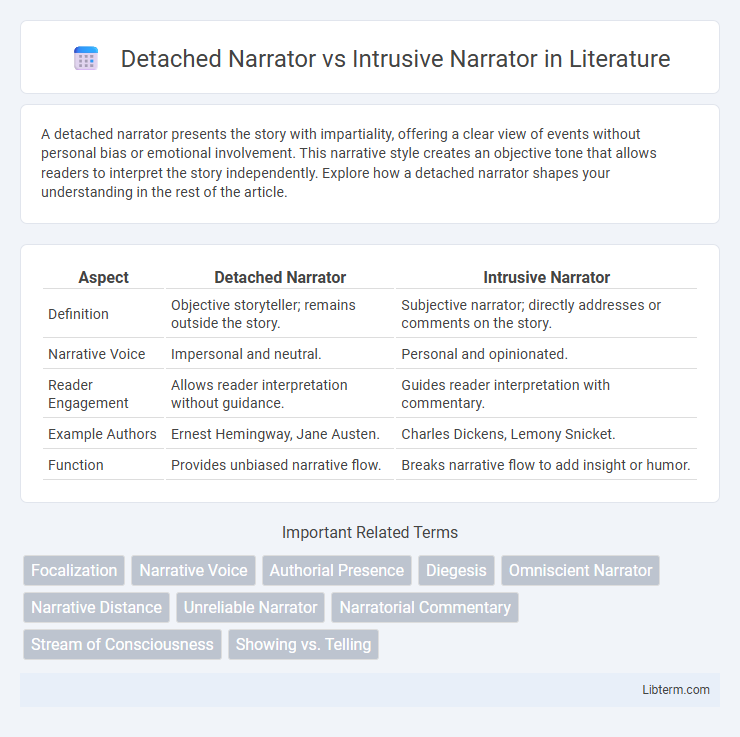A detached narrator presents the story with impartiality, offering a clear view of events without personal bias or emotional involvement. This narrative style creates an objective tone that allows readers to interpret the story independently. Explore how a detached narrator shapes your understanding in the rest of the article.
Table of Comparison
| Aspect | Detached Narrator | Intrusive Narrator |
|---|---|---|
| Definition | Objective storyteller; remains outside the story. | Subjective narrator; directly addresses or comments on the story. |
| Narrative Voice | Impersonal and neutral. | Personal and opinionated. |
| Reader Engagement | Allows reader interpretation without guidance. | Guides reader interpretation with commentary. |
| Example Authors | Ernest Hemingway, Jane Austen. | Charles Dickens, Lemony Snicket. |
| Function | Provides unbiased narrative flow. | Breaks narrative flow to add insight or humor. |
Understanding Narrative Perspectives
Understanding narrative perspectives involves distinguishing between a detached narrator, who provides an objective and unbiased account of the story without inserting personal opinions, and an intrusive narrator, who breaks the fourth wall to directly address the reader with commentary or explanations. A detached narrator maintains distance from characters and events, enhancing the reader's ability to interpret the narrative independently, whereas an intrusive narrator shapes interpretation through subjective insights that guide or challenge reader perception. Recognizing these narrative voices is essential for analyzing how storytelling techniques affect plot development and thematic emphasis.
Defining Detached Narrator
A detached narrator maintains objectivity by presenting the story without revealing personal opinions or emotions, allowing readers to interpret events independently. This narrative style relies heavily on external descriptions and observable actions, avoiding subjective commentary or direct address to the audience. Detached narrators contrast with intrusive narrators, who frequently break the fourth wall to offer personal insights or judgments.
Defining Intrusive Narrator
An intrusive narrator directly addresses the reader, offering commentary, opinions, or explanations that influence the interpretation of the story. This narrator often breaks the fourth wall, providing insights beyond the characters' perspectives and shaping the narrative with subjective judgments. Detached narrators, in contrast, maintain an objective distance, recounting events without personal input or editorializing, allowing readers to form their own conclusions.
Key Characteristics of Detached Narration
Detached narration employs an objective, unbiased perspective, presenting events and characters without the narrator's personal opinions or emotional involvement. This narrative style emphasizes factual description and external observation, allowing readers to interpret the story independently. Key characteristics include limited insight into characters' inner thoughts and a focus on surface-level details, creating a sense of neutrality and distance from the narrative.
Key Traits of Intrusive Narration
Intrusive narration is characterized by the narrator's direct commentary, breaking the fourth wall to address readers with personal opinions or explanations, thus influencing the audience's perspective. This type of narration often includes subjective judgments, moralizing tone, and frequent interruptions within the story to provide context or foreshadowing. The key traits involve a visible narrative voice actively shaping the reader's experience, contrasting with the detached narrator's objective and unobtrusive storytelling style.
Effects on Reader Engagement
A detached narrator offers an objective and impartial perspective, allowing readers to draw their own conclusions and fostering a sense of mystery that encourages active interpretation. An intrusive narrator directly addresses the audience with commentary or judgments, creating intimacy and guiding readers' emotional responses more explicitly. These contrasting narrative styles significantly influence reader engagement by either promoting analytical distance or forging a personal connection with the story.
Influences on Storytelling Tone
Detached narrators create an objective, impartial tone by presenting the story without personal judgment or emotional involvement, allowing readers to interpret events independently. Intrusive narrators shape the storytelling tone through direct commentary, subjective opinions, and emotional reflections, which guide readers' interpretations and create a more intimate or biased narrative atmosphere. The choice between these narrator types significantly impacts the reader's emotional engagement and the overall voice of the story.
Famous Examples in Literature
Detached narrators maintain an objective stance, as seen in F. Scott Fitzgerald's *The Great Gatsby*, where Nick Carraway observes the story without overt commentary. Intrusive narrators break the fourth wall, directly addressing the reader, exemplified by Charles Dickens in *Bleak House*, who frequently offers personal opinions and commentary. These narrative styles influence readers' engagement by shaping the level of intimacy and bias within the storytelling.
Choosing the Right Narrator for Your Story
Choosing the right narrator shapes how readers engage with your story's events and characters. A detached narrator offers an objective, impartial perspective, allowing readers to interpret emotions and motives independently, ideal for stories needing subtlety or ambiguity. In contrast, an intrusive narrator actively comments on the narrative, guiding interpretation and adding personal insight, perfect for works aiming to shape reader opinion or provide critical context.
Comparing Detached vs Intrusive Narrator: Pros and Cons
Detached narrators offer objective storytelling by maintaining emotional distance from characters, which allows readers to interpret events without bias but may result in limited character insight. Intrusive narrators provide direct commentary and personal opinions, enriching the narrative with context and humor yet potentially disrupting immersion by reminding readers of the narrator's presence. Choosing between detached and intrusive narration impacts narrative tone, reader engagement, and depth of character development depending on the story's goals.
Detached Narrator Infographic

 libterm.com
libterm.com